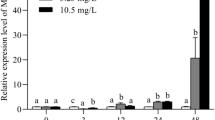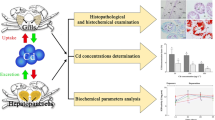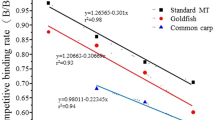Abstract
To study the responses of digestive system of the freshwater crab Sinopotamon henanense to the exposure with cadmium (Cd), crabs were acutely exposed to 7.25, 14.50, and 29.00 mg/l Cd for 96 h and subchronically exposed to 0.725, 1.450, and 2.900 mg/l for 21 days. Cd bioaccumulation in the hepatopancreas and digestive tract (esophagus and intestine) was examined. Furthermore, histopathological alterations of the esophagus, midgut, hindgut, and hepatopancreas were assessed in animals from the 29.0 and 2.90 mg/l Cd treatment groups, and expression of metallothionein messenger RNA (MT mRNA) in the hepatopancreas and intestine was measured in all treatment groups. The results showed difference in the middle and high concentrations between acute and subchronic treatment groups. Cd content in digestive tract after acute 14.5 and 29.0 mg/l Cd exposure was significantly higher than that at subchronic 1.45 and 2.90 mg/l exposure, but Cd levels in hepatopancreas were not significantly different under the same condition. Acute exposure to Cd induced greater morphological damage than subchronic exposure: large areas of epithelial cells were necrotic in hepatopancreas and midgut, which detached from the basal lamina. Vacuolated muscle cells were observed in the hindgut of animals from the acute exposure group, but the changes of esophageal morphology were not obvious after acute or subchronic treatments. The expression of MT mRNA increased with increasing Cd concentration, and MT mRNA level in acute exposure groups was significantly lower when compared to the subchronic exposure groups. Higher Cd content and lower MT mRNA expression in the acutely exposed groups may be responsible for more severe damage of digestive system in these exposure groups.



Similar content being viewed by others
References
Alazemi BM, Lewi JW, Andrews EB (1996) Gill damage in the freshwater fish Gnathonemus petersii (family: Mormyridae) exposed to selected pollutants: an ultrastructural study. Environ Technol 17:225–238
Amiard JC, Amiard-Triquet C, Barka S, Pellerin J, Rainbow PS (2006) Metallothioneins in aquatic invertebrates: their role in metal detoxification and their use as biomarkers. Aquat Toxicol 76:160–202
Annabi A, Messaoudi I, Kerkeni A, Said K (2011) Cadmium accumulation and histological lesion in mosquetofish (Gambusia affinis) tissues following acute and chronic exposure. Int J Environ Res 5(3):745–756
Atli G, Canli M (2010) Response of antioxidant system of freshwater fish Oreochromis niloticus to acute and chronic metal (Cd, Cu, Cr, Zn, Fe) exposures. Ecotoxicol Environ Saf 73:1884–1889
Bais UE, Lokhande MV (2012) Effect of cadmium chloride on histopathological changes in the freshwater fish Ophiocephalus striatus (Channa). Int J Zool Res 8(1):23–32
Barbieri E (2009) Effects of zinc and cadmium on oxygen consumption and ammonium excretion in pink shrimp (Farfantepenaeus paulensis, Pérez-Farfante 1967, Crustacea). Ecotoxicology 18:312–318
Barker PL, Gibson R (1977) Observations on the feeding mechanism, structure of the gut, and digestive physiology of the European lobster Homarus gammarus (L.) (Decapoda: Nephropidae). J Exp Mar Biol Ecol 26(3):297–324
Barker PL, Gibson RJ (1978) Observations on the structure of the mouthparts, histology of the alimentary tract, and digestive physiology of the mud crab Scylla serrata (Decapoda: Portunidae). J Exp Mar Biol Ecol 58:175–191
Cao L, Huan W, Liu JH, Yin XB, Dou SZ (2010) Accumulation and oxidative stress biomarkers in Japanese flounder larvae and juveniles under chronic cadmium exposure. Comp Biochem Physiol C 151:386–392
Cengiz EI, Unlu E (2005) Sublethal effects of commercial delta merthrin on the structure of the gill, liver and gut tissues of mosquitofish, Gambusia affinis: a microscopic study. Environ Toxicol Pharmacol 21:246–253
Cheng HX, Zhao CD, Zhuang GM, XiaWL LYH, Yang K, Nie HF (2008) Reconstruction of the regional soil pollution history by heavy metals in Taihu lake drainage area: taking Pb and Cd as examples. Earth Sci Front 5:167–178
Chiodi Boudet LN, Polizzi P, Romero MB, Robles A, Marcovecchio JE, Gerpe MS (2015) Histopathological and biochemical evidence of hepatopancreatic toxicity caused by cadmium in white shrimp, Palaemonetes argentines. Ecotoxicol Environ Saf 113:231–240
Coombs J, George SG (1978) Mechanisms of immobilization and detoxification of metals in marine organisms. In: McLusky DS, Berry AJ (eds) Physiology and behavior of marine organisms [M]. Pergamon Press, London, pp 179–187
Copenhaver WM, Bunge RP, Bunge MB (1971) Bailey’s textbook of histology [M], 16th edn, Figs. 16–40. Willams & Wilkins, Baltimore, p 446
Correia AD, Livingstone DR, Costa MH (2002) Effects of water-borne copper on metallothionein and lipid peroxidation in the marine amphipod Gammarus locusta. Mar Environ Res 54:357–360
Cui F (2009) Study on cadmium enrichment in aquatic animals and its effect on growth and digestive enzyme activities. Thesis for Master of Science. Nanjing Agricultural University, Nanjing
Cuypers A, Plusquin M, Remans T, Jozefczak M, Keunen E, Gielen H, Opdenakker K, Nair AR, Munters E, Artois TJ, Nawrot T, Vangronsveld J, Smeets K (2010) Cadmium stress: an oxidative challenge. Biometals 23:927–940
Dallinger T (1994) Invertebrate organisms as biological indicators of heavy metal pollution. Appl Biochem Biotechnol 48:27–31
Fang Y, Yang HS, Wang TM, Liu BZ, Zhao HL, Chen MY (2010) Metallothionein and superoxide dismutase responses to sublethal cadmium exposure in the clam Mactra veneriformis. Comp Biochem Physiol C 151(3):325–33
Gao AB, Wang L, Yuan H (2012) Expression of metallothionein cDNA in a freshwater crab, Sinopotamon yangtsekiense, exposed to cadmium. Exp Toxicol Pathol 64(3):253–258
Goto D, Wallace WG (2007) Interaction of Cd and Zn during uptake and loss in the polychaete Capitella capitata: whole body and subcellular perspectives. J Exp Mar Biol Ecol 352(1):65–77
Guardiola FA, Cuest A, Meseguer J, Martínez S, Martínez-Sánchez MJ, Pérez-Sirvent C, Esteban MA (2013) Accumulation, histopathology and immune toxicological effects of waterborne cadmium on gilthead seabream (Sparus aurata). Fish Shellfish Immunol 35(3):792–800
Gurr E (1962) Staining animal tissues: practical and theoretical, 2nd edn. Leonard Hill (Hooks), London
Han T, Wang Q, Wang L (2008) Ecological investigation of freshwater crab and river pollution in basin of Qinhe River. Sichuan J Zool 27:804–806
Hook SE, Fisher NS (2001) Reproductive toxicity of materials in calanoid copepods. Mar Biol 138:1131–1140
Ikechukwu EL, Ajeh EA (2011) Histopathological alterations in the liver and lungs of Hoplobatrachus occipitalis exposed to sub lethal concentrations of cadmium. Aust J Basic Appl Sci 5(11):1062–1068
Jiang YH, Yan SF (2009) Histological and histochemical studies on the digestive tract of Panulirus stimpsoni. J Jimei Univ (Nat Sci) 14(3):1–7
Johnston DJ, Alexander CG, Yellowlees D (1998) Epithelial cytology and function in the digestive gland of Thenus orientalis (Decapoda: Scyllaridae). J Crust Biol 18:271–278
Kang XJ, Mu SM, Li WY, Zhao N (2012) Toxic effects of cadmium on crabs and shrimps. Toxici Drug Test. ISBN: 978-953-51-0004-1
Kaoud HA, Eldahshan AR (2010) Bioaccumulation of cadmium in the freshwater prawn Macrobrachium rosenbergii. Nat Sci 8(4):157–168
Kaya ED, Söyüt H, Beydemir Ş (2015) The toxicological impacts of some heavy metals on carbonic anhydrase from gilthead sea bream (Sparus aurata) gills. Environ Toxicol Pharmacol 39(2):825–832. doi:10.1016/j.etap.2015.01.021
Klaassen CD, Liu J, Diwan BA (2009) Metallothionein protection of cadmium toxicity. Toxicol Appl Pharmacol 238:215–220
Kovarova J, Kizek R, Adam V, Harustiakova D, Celechovska O, Svobodova Z (2009) Effect of cadmium chloride on metallothionein levels in carp. Sensors 9:4789–4803
Kruatrachue M, Rangsayatorn N, Pokethitiyook P, Upatham ES, Singhakaew S (2003) Histopathological changes in the gastrointestinal tract of fish, Puntius gonionotus, fed on dietary cadmium. Bull Environ Contam Toxicol 71:561–569
Li TW, Su XR, Zhang F (1994) Histology, histochemistry of the digestive system in blue crab Portunus trituberculatus (Decapoda, Portunidae). J Liaoning Normal Univ (Nat Sci) 17(3):230–237
Li CL, Cao FJ, Huang XH, Liu CW (2008) Histological observation on alimentary system of Panulirus homarus with light and scanning electron microscopy. J Trop Oceanogr 27(3):72–78
Liu DM, Yang J, Wang L (2013) Cadmium induces ultrastructural changes in the hepatopancreas of the freshwater crab Sinopotamon henanense. Micron 47:24–32
Livak KJ, Schmittgen TD (2001) Analysis of relative gene expression data using real time quantitative PCR and the 2 (-Delta DeltaC (T)) method. Methods 25:402–408
Lou D, Yang JF, Xie H, Chen JG (2010) A preliminary study of comparative histology of major organs from Portunus trituberculatus and Sinopotamon. J Mar Sci 28(3):72–78
Luo LZ, Ke CH, Guo XY, Shi B, Huang MQ (2014) Metal accumulation and differentially expressed proteins in gill of oyster (Crassostrea hongkongensis) exposed to long-term heavy metal-contaminated estuary. Fish Shellfish Immunol 38(2):318–329
Ma WL, Wang L, He YJ, Yang T (2008) Cadmium accumulation and metallothionein biosynthesis in the fresh-water crab Sinopotamon henanense. Acta Sci Circumst 28(6):1192–1197
Ma WL, Yan T, He YJ, Wang L (2009) Purification and cDNA cloning of a cadmium-binding metallothionein from the freshwater crab Sinopotamon henanense. Arch Environ Contam Toxicol 56:747–753
Ma Y, Lin J, Zhang C, Ren Y, Lin J (2011) Cd(II) and As (III) bioaccumulation by recombinant Escherichia coli expressing oligomeric human metallothioneins. J Hazard Mater 185(2–3):1605–1608
Martinez-Finley EJ, Aschner M (2011) Revelations from the nematode Caenorhabditis elegans on the complex interplay of metal toxicological mechanisms. J Toxicol 5(3):745–756
Moltedo O, Verde C, Capasso A, Parisi E, Remondelli P, Bonatti S, Alvarez-Hernandez X, Glass J, Alvino CG, Leone A (2000) Zinc transport and metallothionein secretion in the intestinal human cell line Caco-2. J Biol Chem 275:31819–31825
Nordberg M (1998) Metallothioneins: historical review and state of knowledge. Talanta 46:243–254
Nursita AI, Singh B, Lees E (2009) Cadmium bioaccumulation in Proisotoma minuta in relation to bioavailability in soils. Ecotoxicol Environ Saf 72:1767–1773
Schuwerack PM, Lewis JW (2003) The mode of action of acute and chronic concentrations of waterborne Cd in the digestive gland of the acclimated infested freshwater crab (Potamonautes warreni). Cell Tissue Res 312:249–263
Sevcikova M, Modra H, Slaninova A, Svobodova Z (2011) Metals as a cause of oxidative stress in fish: a review. Vet Med-Czech 56(11):537–546
Silvestre F, Duchêne C, Trausch G, Devos P (2005) Tissue-specific cadmium accumulation and metallothionein-like protein levels during acclimation process in the Chinese crab Eriocheir sinensis. Comp Biochem Physiol C 140(1):39–45
Souid G, Souayed N, Yaktiti F, Maaroufi K (2013) Effect of acute cadmium exposure on metal accumulation and oxidative stress biomarkers of Sparus aurata. Ecotoxicol Environ Saf 89:1–7
Sparla AM, Overnell J (1990) The binding of cadmium to crab cadmium metallothionein. Biochem J 267:539–540
Stará A, Kouba A, Velíšek J (2014) Effect of chronic exposure to prometryne on oxidative stress and antioxidant response in red swamp crayfish (Procambarus clarkii). Biomed Res Int 2014:680131
Strus J, Klepal W, Repina J, Tusek-Znidaric M, Milatovic M, Pipan Z (2008) Ultrastructure of the digestive system and the fate of midgut during embryonic development in Porcellio scaber (Crustacea: Isopoda). Arthropod Struct Dev 37(4):287–298
Tanhan P, Sretarugsa P, Pokethitiyook P, Kruatrachue M, Upatham ES (2005) Histopathological alterations in the edible snail, Babylonia areolata (Spotted Babylon), in acute and sub-chronic cadmium poisoning. Environ Toxicol 20:142–149
Thophon S, Kruatrachue M, Upatham ES, Pokethitiyook P, Sahaphong S, Jaritkhuan S (2003) Histopathological alterations of white seabass, Lates calcarifer, in acute and subchronic cadmium exposure. Environ Pollut 121(3):307–320
Trinchella F, Riggio M, Filosa S, Volpe MG, Parisi E, Scudiero R (2006) Cadmium distribution and metallothionein expression in lizard tissues following acute and chronic cadmium intoxication. Comp Biochem Physiol C 144(3):272–278
Vincent-Hubert F, Châtel A, Gourlay-Francé C (2014) Metallothionein mRNA induction is correlated with the decrease of DNA strand breaks in cadmium exposed zebra mussels. Mutat Res-Gen Tox En 766:10–15
Wang L, Yan B, Liu N, Li YQ, Wang Q (2008) Effects of cadmium on glutathione synthesis in hepatopancreas of freshwater crab, Sinopotamon yangtsekiense. Chemosphere 74:51–56
Wu H, Xuan RJ, Li YJ, Zhang XM, Wang Q, Wang L (2013) Effects of cadmium exposure on digestive enzymes, antioxidant enzymes and lipid peroxidation in the freshwater crab Sinopotamon henanense. Environ Sci Pollut Res 20:4085–4092
Xiang DF, Zhu JQ, Jin S, Hu YJ, Tan FQ, Yang, WX (2013) Expression and function analysis of metallothionein in the testis of Portunus trituberculatus exposed to cadmium. Aquat Toxicol 140–141: 1–10
Yasmeen S, Suryawanshi GD, Mane UH (2012) Histopathological changes in the hepatopancreas of Lamellidens marginalis exposed to cadmium in winter. Int Multidiscip Res J 2(6):41–43
Zhao CD, Chen FR, Chen XR, Zhao HC, Xia WL, Nie HF, Kong M, Liu F, Yang K (2008) A methodology of tracking sources of cadmium anomalies and their quantitative estimation in the Yangtze River basin. Earth Sci Front 15:179–193
Zodrow JM, Stegeman JJ, Tanguay RL (2004) Histological analysis of acute toxicity of 2,3,7,8-tetrachlorodibenzo-p-dioxin (TCDD) in zebrafish. Aquat Toxicol 66:25–38
Acknowledgments
This work was supported by the National Nature Science Foundation (No. 31272319) and the Overseas Returnee Research Fund in Shanxi Province (No. 201015). The authors are thankful to Prof. Hans-Uwe Dahms and Shaoqin Li for critical amendments to the manuscript.
Ethical statement
On behalf of, and having obtained permission from all the authors, I declare that:
-
a)
The material has not been published in whole or in part elsewhere;
-
b)
The paper is not currently being considered for publication elsewhere;
-
c)
All authors have been personally and actively involved in substantive work leading to the report and will be jointly and individually responsible for its content themselves; and
-
d)
All relevant ethical safeguards have been met in relation to animal experimentation.
Author information
Authors and Affiliations
Corresponding author
Additional information
Responsible editor: Markus Hecker
Rights and permissions
About this article
Cite this article
Wu, H., Li, Y., Lang, X. et al. Bioaccumulation, morphological changes, and induction of metallothionein gene expression in the digestive system of the freshwater crab Sinopotamon henanense after exposure to cadmium. Environ Sci Pollut Res 22, 11585–11594 (2015). https://doi.org/10.1007/s11356-015-4419-5
Received:
Accepted:
Published:
Issue Date:
DOI: https://doi.org/10.1007/s11356-015-4419-5




